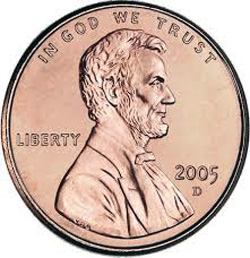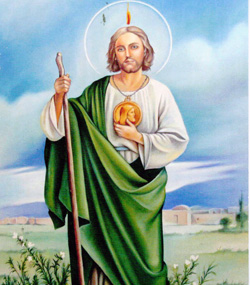
SANTEE, California –I am still pondering two items that neighbor Bob Lauritzen and I found during a walk around the Santee Lakes.
I noticed a card lying face up with Christian iconography on it. The card pictured a man in white robe and green overgarment. He had a halo above his head and within it was something red, perhaps a flame or a red chili. There was a large medal around the man’s neck. He grasped a walking stick with his right hand.
I don’t know which Christian saint the art work was supposed to represent, but perhaps some reader will be kind enough to identify him for me. Notwithstanding that I am a Jew, I felt it would have been a sacrilege to leave the card on the ground where someone might step on the saint’s face. So I picked the card up, and placed it protectively in my shirt pocket.
 A little later in our journey, Bob stooped over to pick a Lincoln penny off the ground. He said there were some who would disparage him for picking up what in monetary value is almost worthless, but “a penny is a penny,” and if a bill at a fast food restaurant ever comes to some odd number like $3.61 he’ll have the penny to make it easier for the cashier to give him change.
A little later in our journey, Bob stooped over to pick a Lincoln penny off the ground. He said there were some who would disparage him for picking up what in monetary value is almost worthless, but “a penny is a penny,” and if a bill at a fast food restaurant ever comes to some odd number like $3.61 he’ll have the penny to make it easier for the cashier to give him change.
So in addition to getting some exercise, and seeing such water fowl as herons, egrets, ducks, cormorants and mudhens, our walk around the Santee Lakes had netted us two very different souvenirs. For Bob, a penny, with the price of metals in fluctuation, may be worth less or more than the raw materials needed to make it, and for me, some sort of religious art from the Christian world. I happen to be fascinated by different religions, so I decided to keep the card and investigate the message it had on its reverse side, which was in Spanish.
Later, I met my son David at the Italian restaurant, Andiamo (“Let’s Go”), in Tierrasanta. Because of its name, I associate Tierrasanta with the “Burning Bush” that Moses encountered on Mount Horeb (which may be the same as Mount Sinai.) Moses was commanded to take off his shoes because he was walking on holy ground — which is “terra santa” in Spanish.
David had learned and spoken Spanish back in the days when he worked in Central America for Price Smart, so I asked him what the message meant on the back of the card. It turned out to be an advertisement for a spiritualist who reads palms and tarot cards. The words of the advertisement recommended the man’s services if I were suffering from depression, impotence or alcoholism. A consultation would cost me only $10 if I were to telephone a certain number in North County.
This made me feel a bit dejected. I thought that Bob had taken home the more materialistic souvenir but it turned out that I did. His penny memorialized a man who often outpolls George Washington as America’s favorite and most inspiring President of all times. Me, I ended up with a pretty crass piece of advertising that used religion for very commercial purposes.
I felt like throwing the card away, but then I realized how inappropriate that would be in Tierrasanta, of all places. I didn’t want the advertisement to land on “holy ground.”
*
POSTSCRIPT: Thanks to Mike Bowler, who correctly identified the image as that of St. Jude, the “patron saint of lost causes.” Wikipedia has this report about the iconography:
Jude is traditionally depicted carrying the image of Jesus in his hand or close to his chest, betokening the legend of the Image of Edessa, recorded in apocryphal correspondence between Jesus and Abgar which is reproduced in Eusebius’ History Ecclesiastica, I, xiii. Eusebius relates that King Abgar of Edessa (now Şanlıurfa in southeast Turkey) sent a letter to Jesus seeking a cure for an illness afflicting him. With the letter he sent his envoy Hannan, the keeper of the archives, offering his own home city to Jesus as a safe dwelling place. The envoy painted a likeness of Jesus with choice paints (or alternatively, impressed with Abgar’s faith, Jesus pressed his face into a cloth and gave it to Hannan) to take to Abgar with his answer. Upon seeing Jesus’ image, the king placed it with great honor in one of his palatial houses. After Christ’s execution, Thomas the Apostle sent Jude to King Abgar and the king was cured. Astonished, he converted to Christianity, along with many of the people under his rule. Additionally, St. Jude is often depicted with a flame above his head, representing his presence at Pentecost, when he was said to have received the Holy Spirit with the other apostles.
*
Harrison is editor of San Diego Jewish World. He may be contacted at donald.harrison@sdjewishworld.com
